We have disassembled a NEC SX-6 supercomputer that had been offline. The machine was installed in a chassis of a tall refrigerator-size box. As we already have somewhat smaller and architecturally similar[1] NEC SX-6i running, we decided not to keep the giant lying around.
Inside the tower there are a large number of very thin coaxial cables[3] that connect processor modules and memory modules.
Processor modules and memory modules seem to construct a complete bipartite graph using the coaxial cables.
As it was hard to detach the connector at the site of dismantlement, we cut the cables.
Below is the picture of cables coming out of a processor module.

The SX-6 CPU Module
The SX-6 CPU die is mounted directly on the PCB.
A power module is socketed to the PCB using a large connector mounted next to the processor die.
Global clock is distributed from the clock module through a thick coaxial cable to the gold connector on the PCB.
The size of the CPU die is 420 mm2 with dimension of 20.5 mm × 20.5 mm.
The PCB itself is 110 mm × 115 mm.
The chip runs at 500 MHz, and is made of 60M transistors using 0.15 μm CMOS with 8-layer Cu interconnect [2].
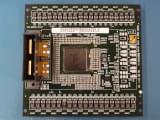
If NEC kept the usual labeling and naming convention for integrated circuits, the SX-6 CPU is called μPD81377-2.
On the other side of the processor module there are 33 connectors.
Green cables attache here.
Each connector has 120 contacts, so this CPU package has 3,960 contacts excluding the dedicated 2-pin power supply connector and 2-contact coaxial clock cable.
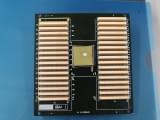
The SX-6 CPU Power Supply Unit
Each CPU unit plugs directly into a dedicated power supply unit with P/N 243-531949.
The label on the power supply unit says it is rated at +1.92V at 100A.
That's the upper bound of power consumption of a single SX-6 CPU!
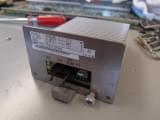
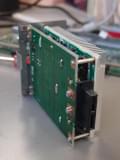
The SX-6 Memory Module MMU Package
We have sixteen Memory modules.
A memory module is composed of a PCB where a controller is located, and sixteen DRAM PCBs
that are about one third the size of a standard DIMM (similar in size to SGI VWS320 memory modules).
This module is called a MMU Package
in NEC literature [2].
The other end of green cables from the processor modules are connected here, and
a thick clock cable from the clock module is attached here too.
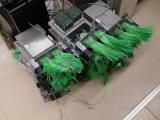
This is the memory base board.
The board contains a memory controller die that is 342.25 mm2 with 18.5 mm × 18.5 mm.
The memory controller die is labeled D81368 1
, 0226K2001
,
so the chip is probably called μPD81368-1 in NEC convention.
Inferring from the die size and operating voltage, this is what Other LSI
refers to in [2].
According to that article, this chip has 50M transistors and runs at 500 MHz.
This chip uses the same 0.15 μm with 8-layer Cu interconnect, and operates with 2.5V and 1.8V power supply.
10 connectors on the left are where the green cables are attached.
Each connector has 120 contacts so 1,200 contacts are used to communicate with the rest of the system.
16 sockets on the right are for memory modules.
The coaxial connector on the bottom is for clock distribution.
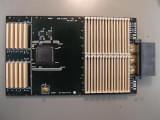
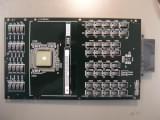
The memory chip is a standard 128 Mbit (16M×8) DDR SDRAM from Hynix (HY5DU28822AT-H).
The module has 170 pins in total (2 rows of 85 pins).
As you can see from the photo, every one pin out of two pins is GND.
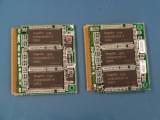
The SX-6 Clock Distribution
Global clock is distributed to CPU modules and memory modules using coaxial cable.
The other end of coaxial connector attaches to the clock distribution board.



Multiple instances of ON Semiconductor MC100E111FN are found on the board.
The chip distributes 5V ECL clock signal.
There are several level shifters for some of the cables: MC100LVEL92 5V PECL-to-LVPECL translator.
All the other coaxial cables are driven using Micrel SY10EL89 cable driver.
The datasheet of the Micrel chip says The device is especially useful in Digital Video Broadcast applications
.
NEC found a creative application for the chip.
The other clock distribution board consists of a large clock distribution tree.
![]()
Other Fun Stuff
We keep the door too.
The design of this door is discussed in [4].
It's worth reading if you read Japanese: it uses very poetic expressions you won't find in other academic papers.
I like the style of this door nevertheless.
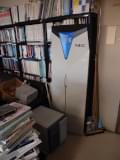
References
- Takeshi Nishikawa, Takeshi Fukushima, Mitsuyasu Hanamura, Gizo Kadaira and Shigenori Takekawa:
Major Features and Outline of Supercomputer SX-6
. In NEC Giho. Volume 55 Number 9. pp.7-10. 2002. - Tatsuo Satoh, Rikikazu Ikeda, Toshiharu Sobue, Takashi Oguri, Hiroki Inohara and Shitaka Yamada:
LSI Technology and Circuit Technology for SX-6
. In NEC Giho. Volume 55 Number 9. pp.20-23. 2002. - Hiroyuki Hamaguchi, Kazuhiko Umezawa, Masahiro Yamauchi, Masahiro Yamada and Masaki Shimura:
Packaging Technology for SX-6
. In NEC Giho. Volume 55 Number 9. pp.24-25. 2002. - Tetsuya Nagata, Naoki Kato and Masatsugu Murakami:
Design of Suprcomputer SX-6
. In NEC Giho Volume 55 Number 9. pp.34-35. 2002.